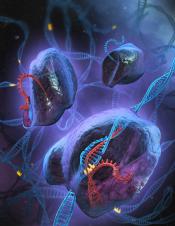1st Patients To Get CRISPR Gene-Editing Treatment Continue To Thrive
By Rob Stein,
NPR
| 12. 15. 2020
The last thing a lot of people want to do these days is get on a plane. But even a pandemic would not stop Victoria Gray. She jumped at the chance to head to the airport this summer.
"It was one of those things I was waiting to get a chance to do," says Gray.
She had never flown before because she was born with sickle cell disease. She feared the altitude change might trigger one of the worst complications of the devastating genetic disease — a sudden attack of excruciating pain.
But Gray is the first person in the United States to be successfully treated for a genetic disorder with the help of CRISPR, a revolutionary gene-editing technique that makes it much easier to make very precise changes in DNA.
About a year after getting the treatment, it was working so well that Gray felt comfortable flying for the first time. She went to Washington, D.C., to visit her husband, who has been away for months on deployment with the National Guard.
"It was exciting. I...
Related Articles
By Jenny Lange, BioNews | 12.01.2025
A UK toddler with a rare genetic condition was the first person to receive a new gene therapy that appears to halt disease progression.
Oliver, now three years old, has Hunter syndrome, an inherited genetic disorder that leads to physical...
By Rachel Hall, The Guardian | 11.20.2025
Couples are needlessly going through IVF because male infertility is under-researched, with the NHS too often failing to diagnose treatable causes, leading experts have said.
Poor understanding among GPs and a lack of specialists and NHS testing means male infertility...
By Pam Belluck and Carl Zimmer, The New York Times | 11.19.2025
Gene-editing therapies offer great hope for treating rare diseases, but they face big hurdles: the tremendous time and resources involved in devising a treatment that might only apply to a small number of patients.
A study published on Wednesday...
By Aisha Down, The Guardian | 11.10.2025
It has been an excellent year for neurotech, if you ignore the people funding it. In August, a tiny brain implant successfully decoded the inner speech of paralysis patients. In October, an eye implant restored sight to patients who had...




